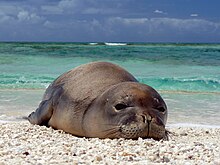Monachus
| Monk seals | |
|---|---|
 |
|
| Hawaiian monk seal | |
| Scientific classification | |
| Kingdom: | Animalia |
| Phylum: | Chordata |
| Class: | Mammalia |
| Order: | Carnivora |
| Suborder: | Caniformia |
| Clade: | Pinnipedia |
| Family: | Phocidae |
| Tribe: |
Monachini Scheffer, 1958 |
| Species | |
|
Monachus monachus |
|
 |
|
| Hawaiian monk seal range | |
 |
|
| Mediterranean monk seal range | |
Monachus monachus
Neomonachus schauinslandi
†Neomonachus tropicalis
Monk seals are earless seals of the tribe Monachini. They are the only earless seals found in tropical climates. There are two genera of monk seals, Monachus and Neomonachus, comprising three species: the Mediterranean monk seal, Monachus monachus; the Hawaiian monk seal, Neomonachus schauinslandi; and the Caribbean monk seal, Neomonachus tropicalis, which became extinct in the 20th century. The two surviving species are now extremely rare and in imminent danger of extinction. All three monk seal species were classified in genus Monachus until 2014, when the Caribbean and Hawaiian species were placed into a new genus, Neomonachus.
Monk seals have a slender body and are agile. They have a broad, flat snout with nostrils on the top. Monk seals are polygynous, and group together in harems. They feed mainly on bony fish and cephalopods, but they are opportunistic. The skin is covered in small hair, which are generally black in males and brown or dark gray in females. Monk seals are found in the Hawaiian archipelago, certain areas in the Mediterranean sea (such as Cabo Blanco and Gyaros island), and formerly in the tropical areas of the west Atlantic Ocean.
All species experienced over-hunting by sealers. The Hawaiian monk seal experienced population drops in the 19th century and during World War II, and the Caribbean monk seal was exploited since the 1500s until the 1850s, when populations were too low to hunt commercially. The Mediterranean monk seal has experienced commercial hunting since the Middle Ages and eradication by fishermen. Monk seals have developed a fear of humans, and may even abandon beaches due to human presence. There are currently around 1,700 monk seals in total.
...
Wikipedia
